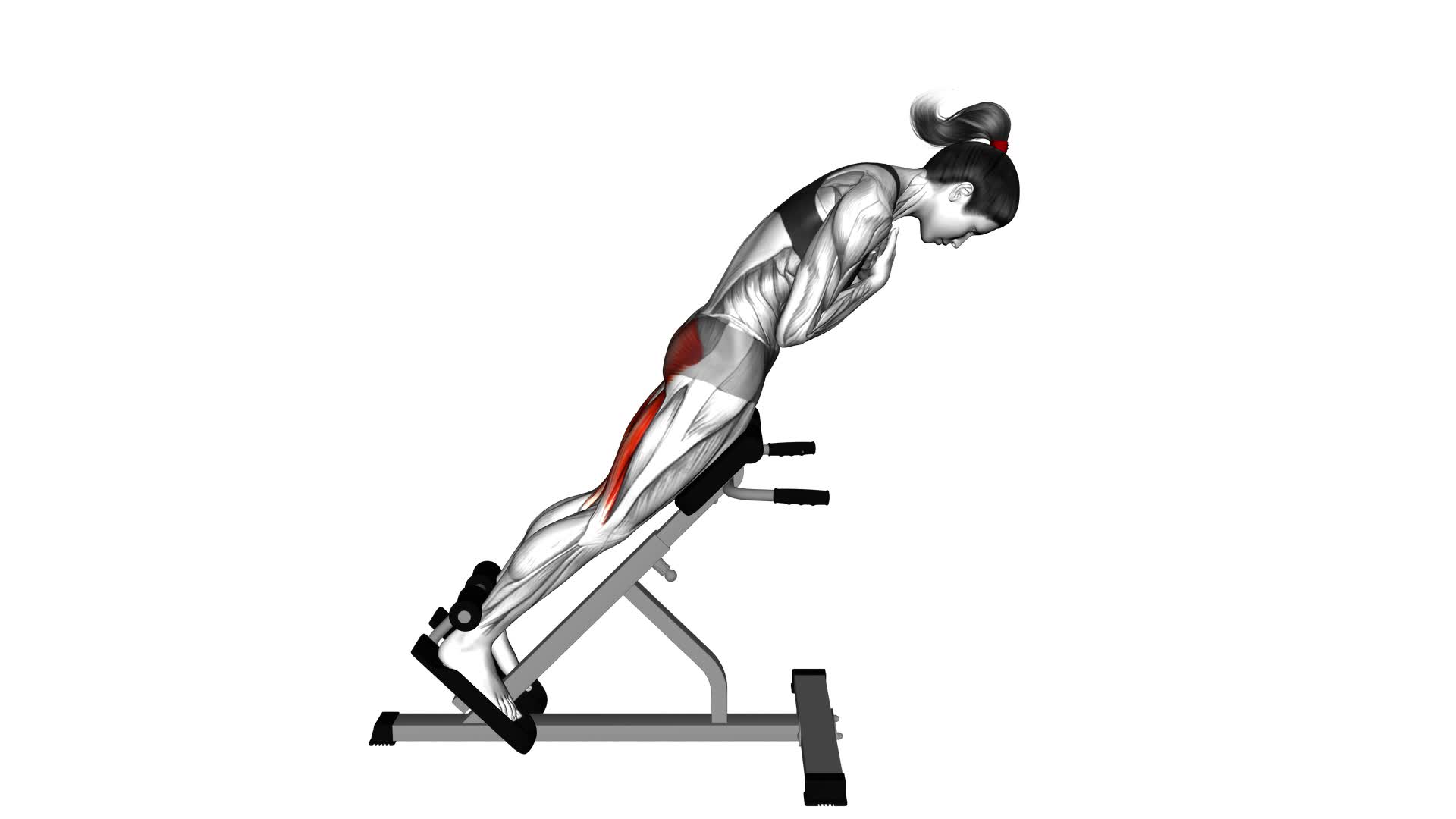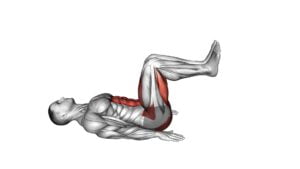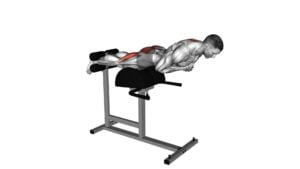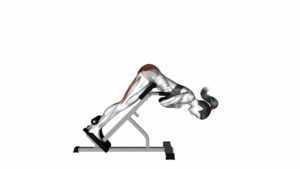45 Degree Hip Extension Glute Focused (female) – Video Exercise Guide & Tips

Are you looking to strengthen and target your glute muscles? Look no further than the 45 Degree Hip Extension exercise!
Watch This Exercise Video
In this video exercise guide, we'll show you the proper form and technique to get the most out of this glute-focused workout. Learn variations to target different areas of your glutes and avoid common mistakes.
Follow our tips to maximize your results and take your glute training to the next level.
Let's get started!
Key Takeaways
- Targets gluteus maximus, the largest muscle in the buttocks
- Enhances hip extension and lower body strength
- Improves athletic performance and prevents injuries
- Activates and strengthens glutes effectively
Benefits of 45 Degree Hip Extension
You can maximize your glute activation and strengthen your hip muscles with the benefits of 45 degree hip extension. This exercise specifically targets the gluteus maximus, which is the largest muscle in your buttocks and plays a crucial role in hip extension and overall lower body strength. By performing 45 degree hip extensions, you can effectively activate and strengthen your glutes, enhancing your athletic performance and preventing injuries.
During this exercise, you lie face-down on a 45 degree bench with your hips positioned at the edge. Start by placing your hands on the sides of your head and keep your feet anchored securely. Engage your glutes and lift your upper body off the bench, extending your hips until your body forms a straight line from head to heels. Hold this position for a second and then lower your body back down slowly.
The benefits of 45 degree hip extension go beyond just glute activation. It also helps to improve your overall lower body strength and stability. By incorporating this exercise into your strength training routine, you can enhance your performance in activities such as running, jumping, and squatting. Remember to start with lighter weights and gradually increase the resistance as you become stronger.
Proper Form and Technique
To ensure proper form and technique for maximum effectiveness, focus on using a controlled and fluid motion during the 45 degree hip extension exercise. This exercise not only targets the glutes but also helps in improving balance and incorporating resistance for a more challenging workout.
Start by positioning yourself on the 45-degree angled hip extension machine. Place your feet shoulder-width apart, ensuring that your knees are in line with your hips. Keep your back straight and engage your core throughout the exercise.
As you begin the movement, exhale and extend your hips while pushing against the resistance. Keep your glutes activated and avoid using momentum to swing your legs up. Instead, focus on a slow and controlled motion, squeezing your glutes at the top of the movement.
Maintain proper alignment of your knees and hips throughout the exercise. Avoid arching your back or hyperextending your spine. Remember to inhale as you lower your legs back to the starting position.
Incorporating resistance by adjusting the weight on the machine will increase the challenge and help in building stronger glutes. However, it's crucial to maintain proper form and technique to prevent injury and ensure maximum benefits.
Variations to Target Different Glute Muscles
To further target different glute muscles, incorporate variations into your hip extension exercises. By adding these variations, you can enhance the effectiveness of your glute activation exercises and utilize glute isolation techniques.
One variation you can try is the single-leg hip extension. With this exercise, you perform the hip extension movement with one leg at a time, allowing for a more targeted activation of the glutes.
Another variation is the banded hip extension. By placing a resistance band just above your knees and performing the hip extension movement, you can increase glute activation by providing additional resistance and forcing the glutes to work harder.
Additionally, you can try the glute bridge exercise. This exercise involves lying on your back with your knees bent and feet flat on the ground, then lifting your hips up towards the ceiling. This movement primarily targets the glutes and can be modified by placing a weight or resistance band on your hips for added resistance.
Common Mistakes to Avoid
One common mistake to avoid during degree hip extension exercises is improper form. It's crucial to maintain proper alignment throughout the movement to effectively target the glute muscles. One common mistake is arching the lower back excessively, which can lead to strain in the lumbar spine. To avoid this, engage your core and keep your spine neutral throughout the exercise.
Another mistake to avoid is relying solely on momentum instead of using the glute muscles to initiate and control the movement. This can limit the effectiveness of the exercise. Instead, focus on consciously contracting the glutes as you lift your leg, and lower it back down slowly and under control.
Additionally, it's important to avoid compensating with other muscles, such as the hamstrings or lower back. To prevent this, start with a light resistance and gradually increase it as your glute strength improves.
Tips for Maximizing Results
To get the most out of your degree hip extension glute exercises, focus on engaging your glute muscles throughout the entire movement. This will ensure that you're targeting the right muscles and maximizing the effectiveness of the exercise.
Additionally, there are a few other tips that can help you maximize your results.
Firstly, it's important to stay motivated. Consistency is key when it comes to seeing results from your workouts. Set specific goals for yourself and track your progress to stay motivated. Celebrate small victories along the way to keep yourself engaged and excited about your workouts.
Secondly, rest days are just as important as your workout days. Allow your muscles time to recover and repair by incorporating rest days into your exercise routine. Rest days not only help prevent overtraining and reduce the risk of injury, but they also promote muscle growth and strength development. Listen to your body and give it the rest it needs to perform at its best.
Frequently Asked Questions
How Many Sets and Reps Should I Do for the 45 Degree Hip Extension Exercise?
To determine the number of sets and reps for the 45 degree hip extension exercise, consider your fitness level and goals. Start with 2-3 sets of 10-15 reps, focusing on engaging your glutes throughout the movement.
If you have a hip injury, it's important to modify the exercise to avoid aggravating the injury. Consult with a fitness professional or physical therapist for specific modifications that suit your needs.
Remember to always listen to your body and adjust accordingly.
Can I Do the 45 Degree Hip Extension Exercise if I Have a Previous Hip Injury?
If you have a previous hip injury, it's important to be cautious when doing the 45 degree hip extension exercise. It's recommended to consult with a healthcare professional or a qualified trainer who can assess your specific situation.
They can provide alternative hip extension exercises that are safer for your hip and can help you strengthen your glutes without causing further injury.
Remember to always prioritize your safety and listen to your body during any exercise routine.
Is It Necessary to Use a Bench or Can I Perform the Exercise on the Floor?
To perform the 45 degree hip extension exercise, it isn't necessary to use a bench. You can actually do it on the floor. However, keep in mind that using a bench can provide more stability and support.
If you choose to perform it on the floor, make sure to use a mat or towel for comfort. To modify the exercise, you can decrease the range of motion or use resistance bands for added difficulty.
Can I Add Resistance or Weights to the 45 Degree Hip Extension Exercise?
Yes, you can definitely add resistance or weights to the 45 degree hip extension exercise. Doing so will increase the challenge and intensity of the exercise, helping you to build stronger glutes. Adding resistance can be done by using resistance bands, ankle weights, or holding dumbbells.
The benefits of hip extension exercises include strengthening your glute muscles, improving hip stability, and enhancing overall lower body strength. So go ahead and add some resistance to take your hip extension exercise to the next level!
How Long Does It Take to See Results From Doing the 45 Degree Hip Extension Exercise Regularly?
To see optimal results from the 45 degree hip extension exercise, it's important to perform it regularly. Engaging your glutes properly during this exercise is key. Make sure to squeeze your glutes at the top of the movement and maintain a controlled pace throughout.
Aim for a frequency of at least three times a week, allowing for rest and recovery in between sessions. Consistency and proper form are key to seeing results.
Conclusion
In conclusion, the 45-degree hip extension exercise is a highly effective way to target and strengthen the glute muscles. By maintaining proper form and technique, varying the exercise to target different glute muscles, avoiding common mistakes, and implementing tips for maximizing results, individuals can achieve optimal benefits from this exercise.
Incorporating this exercise into a regular workout routine can help improve glute strength and overall lower body stability.

Author
Years ago, the spark of my life’s passion ignited in my mind the moment I stepped into the local gym for the first time. The inaugural bead of perspiration, the initial endeavor, the very first surge of endorphins, and a sense of pride that washed over me post-workout marked the beginning of my deep-seated interest in strength sports, fitness, and sports nutrition. This very curiosity blossomed rapidly into a profound fascination, propelling me to earn a Master’s degree in Physical Education from the Academy of Physical Education in Krakow, followed by a Sports Manager diploma from the Jagiellonian University. My journey of growth led me to gain more specialized qualifications, such as being a certified personal trainer with a focus on sports dietetics, a lifeguard, and an instructor for wellness and corrective gymnastics. Theoretical knowledge paired seamlessly with practical experience, reinforcing my belief that the transformation of individuals under my guidance was also a reflection of my personal growth. This belief holds true even today. Each day, I strive to push the boundaries and explore new realms. These realms gently elevate me to greater heights. The unique combination of passion for my field and the continuous quest for growth fuels my drive to break new ground.







